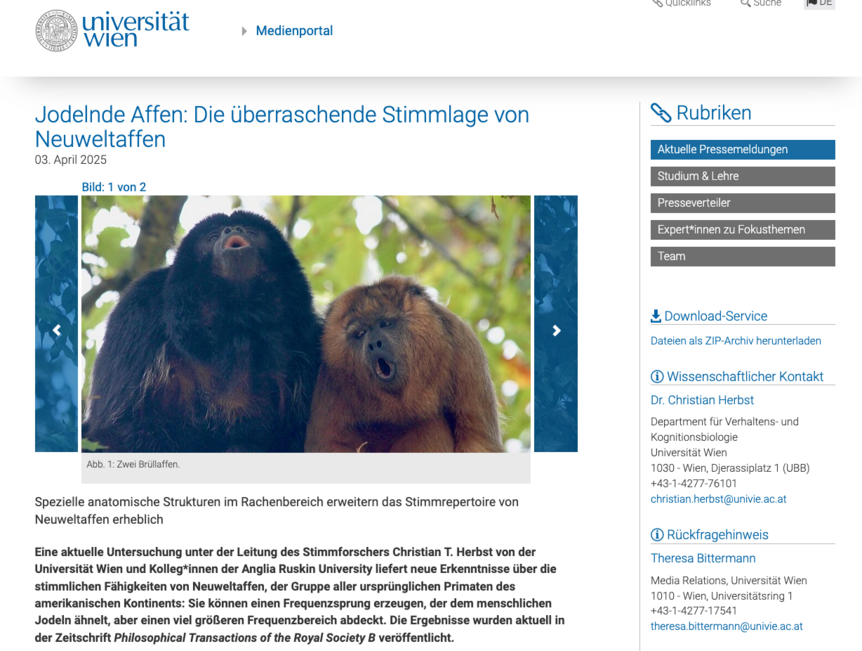News & Events
21.11.2025
22.09.2025
21.07.2025
09.07.2025
Publications
Showing entries 811 - 840 out of 1393
Fitch WT, Suthers RA, Fay RR, Popper AN. Vertebrate Sound Production and Acoustic Communication. Springer Handbook of Auditory Research. 2016 Apr 28;53.
Güntürkün O, Bugnyar T. Cognition without Cortex. Trends in Cognitive Science. 2016 Apr;20(4):291–303. doi: 10.1016/j.tics.2016.02.001
Lupi S, Goymann W, Cardinale M, Fusani L. Physiological conditions influence stopover behaviour of short-distance migratory passerines. Journal of Ornithology. 2016 Apr;157(2):583–589. doi: 10.1007/s10336-015-1303-5
Loretto MC, Schuster R, Reimann S, Graulich DM, Bugnyar T. Raumnutzung nicht-brütender Kolkraben nahe einer dauerhaften menschlichen Nahrungsquelle. Journal of Ornithology. 2016 Apr;157(2):439–450. doi: 10.1007/s10336-015-1289-z
Ringler E, Pasukonis A, Ringler M, Huber L. Sex-specific offspring discrimination reflects respective risks and costs of misdirected care in a poison frog. Animal Behaviour. 2016 Apr;114:173-179. doi: 10.1016/j.anbehav.2016.02.008
Garcia M, Gingras B, Bowling D, Herbst C, Böckle M, Locatelli Y et al. Structural classification of Wild Boar (Sus scrofa) vocalizations. Ethology. 2016 Apr;122(4):329-342. doi: 10.1111/eth.12472
Tebbich S, Griffin AS, Peschl FM, Sterelny K. From mechanisms to function: an integrated framework of animal innovation. Philosophical Transactions of the Royal Society of London. Biological Sciences. 2016 Mar 19;371(1690):1-11. 20150195. doi: 10.1098/rstb.2015.0195
Fitch WT. Dance, Music, Meter and Groove: A Forgotten Partnership. Frontiers in Human Neuroscience. 2016 Mar 1;10(64). doi: 10.3389/fnhum.2016.00064
Schmitt V, Federspiel I, Eckert J, Keupp S, Tschernek L, Faraut L et al. Do monkeys compare themselves to others? Animal Cognition. 2016 Mar;19:417–428. doi: 10.1007/s10071-015-0943-4
Hampala V, Garcia M, Svec J, Scherer RC, Herbst C. Relationship Between the Electroglottographic Signal and Vocal Fold Contact Area. Journal of Voice. 2016 Mar;30(2):161-171. Epub 2015 Aug 6. doi: 10.1016/j.jvoice.2015.03.018
Morton FB, Brosnan SF, Prétôt L, Buchanan-Smith HM, O'sullivan E, Stocker M et al. Using photographs to study animal social cognition and behaviour: Do capuchins' responses to photos reflect reality? Behavioural Processes. 2016 Mar;124:38–46. doi: 10.1016/j.beproc.2015.10.005
Miller R, Laskowski KL, Schiestl M, Bugnyar T, Schwab C. Socially Driven Consistent Behavioural Differences during Development in Common Ravens and Carrion Crows. PLoS ONE. 2016 Feb 5;11(2):e0148822. doi: 10.1371/journal.pone.0148822
Kotrschal K. Do companion animals support social, emotional and cognitive development of children? In Freund LS, McCune S, McCardle P, Esposito L, Gee NR, editors, Social Neuroscience of Human-Animal Interaction. NIH-Waltham Symposium on HAI and Child Development, Washington. 1 ed. American Psychological Association (APA). 2016
Sima M, Pika S, Bugnyar T. Experimental Manipulation of Food Accessibility Affects Conflict Management Behaviour in Ravens. Ethology. 2016 Feb;122(2):114–126. doi: 10.1111/eth.12451
Stocker M, Munteanu MA, Stöwe M, Schwab C, Palme R, Bugnyar T. Loner or socializer? Ravens' adrenocortical response to individual separation depends on social integration. Hormones and Behavior. 2016 Feb;78:194-199. doi: 10.1016/j.yhbeh.2015.11.009
Bugnyar T, Reber S, Buckner C. Ravens attribute visual access to unseen competitors. Nature Communications. 2016 Feb;7:10506. doi: 10.1038/ncomms10506
Nemeth M, Pschernig E, Wallner B, Millesi E. Non-invasive cortisol measurements as indicators of physiological stress responses in guinea pigs. PeerJ. 2016 Jan 18;4(1):e1590. doi: 10.7717/peerj.1590
Ringler M, Mangione R, Pasukonis A, Rainer G, Gyimesi K, Felling J et al. High-resolution forest mapping for behavioural studies in the Nature Reserve 'Les Nouragues', French Guiana. Journal of Maps. 2016 Jan 1;12(1):26-32. doi: 10.1080/17445647.2014.972995
Hungerländer NA, Horn L, Bugnyar T, Windhager S, Massen JJM. A comparative approach to prosocial behaviour in children. In 8th European Conference of Behavioural Biology (ECBB): Vienna July 12-15, 2016 ; Book of Abstracts. Vienna. 2016
Beck K, Frigerio D, Loretto MC. Der Kolkrabe – Schwarzfedriges Genie oder doch nur ein Unglücksbote? - Von Irrtümern und Mythen bis hin zur Forschung von Groß und Klein. Öko-L : Zeitschrift für Ökologie, Natur- und Umweltschutz. 2016;3-11.
Huber L, O'Hara M. Extractive Foraging Hypothesis, The (Parker and Gibson 1997, 2015). In Encyclopedia of Evolutionary Psychological Science. Springer International Publishing AG . 2016
Kotrschal K, Scheiber IBR, Hirschenhauser K. Individual Performance in Complex Social Systems: The Greylag Goose Example. In Kappeler P, editor, Animal Behaviour: Evolution & Mechanisms. Heidelberg: Springer. 2016. p. 121-148
Narins P, Stöger-Horwath A, O’Connell-Rodwell C. Infrasonic and Seismic Communication in the Vertebrates with Special Emphasis on the Afrotheria: An Update and Future Directions. In Vertebrate Sound Production and Acoustic Communication. Springer. 2016. p. 191-227. (Springer Handbook of Auditory Research).
Frischauf C, Gockert R, Kavcik-Graumann N, Rabeder G. "Kiskevély knifes" indicate the menu of Alpine cave bears - Comparative studies on wedge shaped defects of canines and incisors. Cranium. 2016;33(1):14-17.
Fitch WT. Laryngeal Descent. In Encyclopedia of Evolutionary Psychological Science . Springer. 2016. p. 1-4
Fitch WT. Reinventing Linguistics – Again. Inference: International Review of Science. 2016;2(3):1-10.
Hirschenhauser K, Gürtler H, Millesi E. Salivary cortisol patterns in nine-year old children – testing the effects of daily exercises on school-related stress load. Etho News. 2016;74:8-12.
Schöberl GI, Beetz A, Solomon J, Wedl M, Gee N, Kotrschal K. Social factors influencing cortisol modulation in dogs during a strange situation procedure. Journal of Veterinary Behavior: Clinical Applications and Research. 2016;11:77-85. doi: 10.1016/j.jveb.2015.09.007
Showing entries 811 - 840 out of 1393






